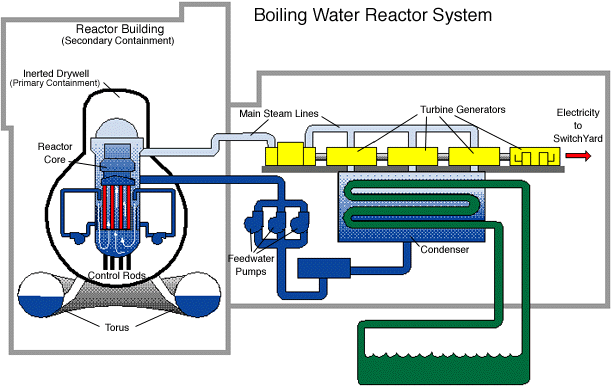
Boiling Water Reactor (BWR)
BWR is the abbreviation for the Boiling Water Reactor. These reactors were originally designed by Allis-Chambers and General Electric (GE). The General Electric design has survived, whereas all Allis-Chambers units are now shutdown. The first GE US commercial plant was at Humboldt Bay (near Eureka) in California. Other suppliers of the BWR design world-wide have included - ASEA-Atom, Kraftwerk Union, Hitachi. Commercial BWR reactors may be found in Finland, Germany, India, Japan, Mexico, Netherlands, Spain, Sweden, Switzerland, and Taiwan. Japan and Taiwan have the newest BWR units.
The BWR reactor typically allows bulk boiling of the water in the reactor. The operating temperature of the reactor is approximately 570F producing steam at a pressure of about 1000 pounds per square inch. Current BWR reactors have electrical outputs of 570 to 1300 MWe. As this the PWR designs, the units are about 33% efficient.
Reproduced by permission
In the figure above, water is circulated through the Reactor Core picking up heat as the water moves past the fuel assemblies. The water eventually is heated enough to convert to steam. Steam separators in the upper part of the reactor remove water from the steam.
The steam then passes through the Main Steam Lines to the Turbine-Generators. The steam typically goes first to a smaller High Pressure (HP) Turbine, then passes to Moisture Separators (not shown), then to the 2 or 3 larger Low Pressure (LP) Turbines. In the sketch above there are 3 low pressure turbines, as is common for 1000 MWe plant. The turbines are connected to each other and to the Generator by a long shaft (not one piece).
The Generator produces the electricity, typically at about 20,000 volts AC. This electrical power is then distributed to a Generator Transformer, which steps up the voltage to either 230,000 or 345,000 volts. Then the power is distributed to a switchyard or substation where the power is then sent offsite.
The steam, after passing through the turbines, then condenses in the Condenser, which is at a vacuum and is cooled by ocean, sea, lake, or river water. The condensed steam then is pumped to Low Pressure Feedwater Heaters (shown but not identified). The water then passes to the Feedwater Pumps which in turn, pump the water to the reactor and start the cycle all over again.
The BWR is unique in that the Control Rods, used to shutdown the reactor and maintain an uniform power distribution across the reactor, are inserted from the bottom by a high pressure hydraulically operated system. The BWR also has a Torus (shown above) or a Suppression Pool. The torus or suppression pool is used to remove heat released if an event occurs in which large quantities of steam are released from the reactor or the Reactor Recirculation System, used to circulate water through the reactor.
The General Electric BWR designs are designated BWR-1 through BWR-6. Typical examples of each of these classes of BWR are:
Inside the BWR illustrates the equipment used.
Copyright © 1996-2006. The Virtual Nuclear Tourist. All rights reserved. Revised: December 19, 2005.